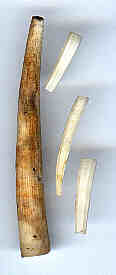Your path =Home>Beadmaking & Materials>Organic Materials> Seashells
Beads from the Sea Shore
Click here for the Shell Bead Gallery
The most likely process that initiated the making of beads from shell is beach combing. We know prehistoric people were curious and collected fossils, crystals and such things without having any apparent function.
They no doubt collected things from the beach as well.
It has been suggested that when early humans started eating fish they were on their way
to developing into modern people.
Food aside, there are a lot of interesting things to find on a beach.
|
Some shells would have suggested themselves being turned into beads.
A small group of shells is naturally perforated.
|
|||||||
Other shells are perforated by sea action after the death of the animal, sometimes resulting in "beads" just the way humans make them: cowries with backs broken off;
conus shell tops with holes in the center; and small snails with a hole on one side. Still others have a neatly drilled circular hole made by a predator (such as conus) that uses its hard tongue to drill into a shell of another animal to eat it.
There are beaches where many naturally perforated shells are found. In an old Native American village in Arizona an archaeologist found the tops of conus and olive shells strung together so the two halves made a round bead. She was puzzled why they were
not ground down very neatly. Years later, she found the same "beads" on a beach in California, and realized that they were once gathered on the beach and traded hundreds
of miles to be worn as beads.
|
__________________________________________________
Small Bead Businesses | Beading & Beadwork | Ancient Beads | Trade Beads
Beadmaking & Materials | Bead Uses | Researching Beads | Beads and People
Center for Bead Research | Book Store | Free Store | Bead Bazaar
Shopping Mall | The Bead Auction | Galleries | People | Events
The Bead Site Home | Chat Line | Contact Us | Site Search Engine | FAQ



